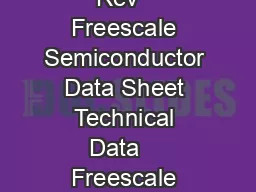PDF-Freescale SemiconductorApplication Note
Author : faustina-dinatale | Published Date : 2016-07-28
AN2254Rev 1 112004
Presentation Embed Code
Download Presentation
Download Presentation The PPT/PDF document "Freescale SemiconductorApplication Note" is the property of its rightful owner. Permission is granted to download and print the materials on this website for personal, non-commercial use only, and to display it on your personal computer provided you do not modify the materials and that you retain all copyright notices contained in the materials. By downloading content from our website, you accept the terms of this agreement.
Freescale SemiconductorApplication Note: Transcript
AN2254Rev 1 112004. 6 032013 20072009 20122013 Freescale Semiconductor Inc All rights reserved Contents Tilt Sensing Using a ThreeAxis Accelerometer by Mark Pedley 1 Introduction Accelerometers are sensitive to both linear acceleration and the local gravitational fiel 20062009 All rights reserved Pressure Integrated Silicon Pressure Sensor Manifold Absolute Pressure Sensor OnChip Signal Conditioned Temperature Compensated and Calibrated The MPX4250A series Manifold Absolute Pressure MAP sensor for engine control 20062009 All rights reserved Pressure Integrated Silicon Pressure Sensor OnChip Signal Conditioned Temperature Compensated and Calibrated The MPX4250 series piezoresistive transducer is a stateoftheart monolithic silicon pressure sensor de signed f All rights reserved Pressure 200 kPa OnChip Temperature Compensated Silicon Pressure Sensors The MPX2202 devices series are silicon piezoresistive pressure sensor providing a highly accurate and linear voltage output directly proportional to the app in the US and other countries All other product or service names are the property of their respective owners Freescale Semiconductor Inc 2012 Document Number MC33931FS REV 10 Features Benefits Ordering Information Part Number Temp Ranges T Package 3 012012 Freescale Semiconductor Inc 2012 All rights reserved Contents 1 Introduction This technical note provides the mathematics reference source code and guidance for engineers implementing a tiltcompensated electr onic compass eCompass The eCom 0 102008 Contents 57513 Freescale Semiconductor Inc 2008 All rights reserved 1 Introduction 11 Emulated EEPROM Some families of the S12X series of microcontrollers MCUs such as the MC9S12XEP100 have an enhanced region labeled as EEPROM in the memory Contents Vybrid. Carl Chien/Sr. FAE. Agenda. Host Requirements and Setup. BSP Download . Target Requirements. SD Card boot-up. 2. Host Requirements . Modern GNU/Linux Distribution. While you can use nearly any modern Linux distribution released in the last 24 months, . AN1942Rev. 1, 08/2005 Contents
Download Document
Here is the link to download the presentation.
"Freescale SemiconductorApplication Note"The content belongs to its owner. You may download and print it for personal use, without modification, and keep all copyright notices. By downloading, you agree to these terms.
Related Documents



